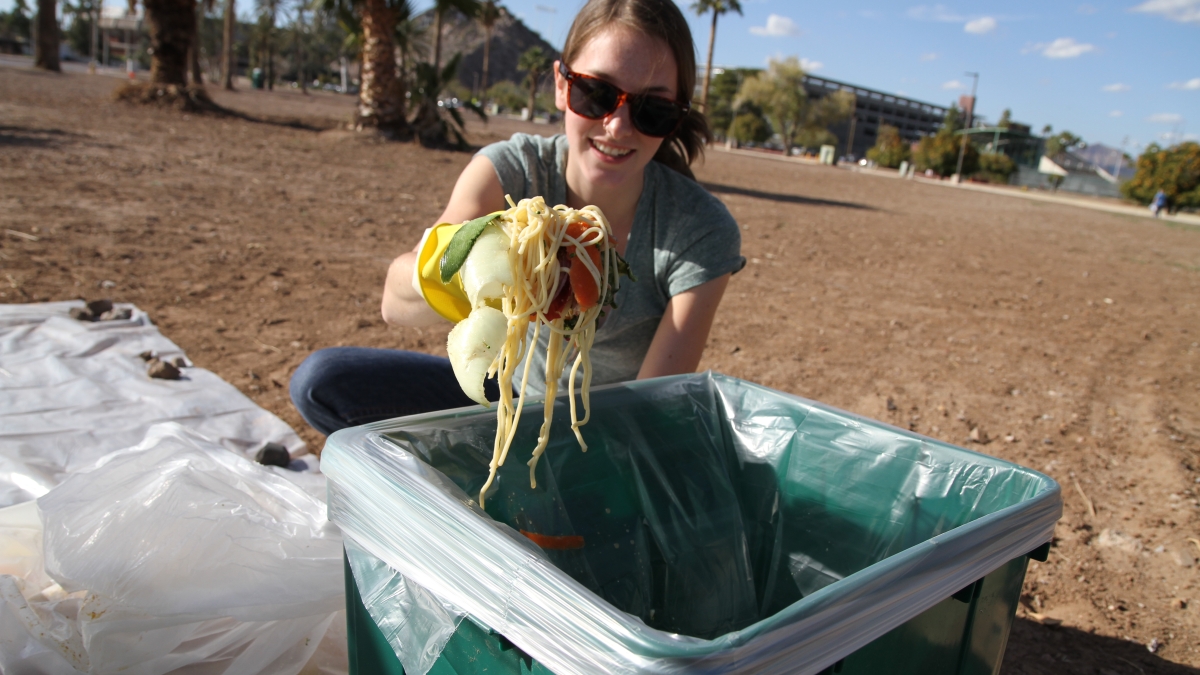Getting dirty to clean up ASU's organic waste

It’s a dirty job, and ASU students rallied to do it.
Rolling up their sleeves and getting down and grimy with a full day’s waste from a campus dining hall was just part of regular class activities for students in the School of Sustainability’s Urban Composting Systems solutions workshop.
Aaron Redman, a faculty associate within the Global Institute of Sustainability (GIOS), co-instructs the course with Katja Brundiers, a GIOS academic associate. The pair designed the class – comprised of six graduate and 16 undergraduate students – to assess ASU’s food-waste system, develop a reasonable vision of a sustainable food-waste system, and build strategies that help transition from current practices towards a sustainable system.
“The purpose of creating 'real world learning' experiences such as this course is that it equips students to tackle sustainability problems in ways no 'typical' academic course can,” Redman says.
To gain a better understanding of the food-waste volume created on a regular day in ASU dining halls, students mired themselves in the dirty details by conducting a waste audit. Just after breakfast at 7 a.m., in mid-February, rubber-gloved students gathered at the loading dock of Hassayampa dining hall on the ASU Tempe campus. Until 10 p.m., students worked in shifts, sorting through items destined for the landfill or a recycling facility. According to data compiled by students, 69 bags of organic waste, recyclables and trash were collected, weighing in at more than 800 pounds. The bags were sorted into groups of pre- and post-consumer waste, trash, and recycling items at a site located on the northwest corner of Rural Road and University Avenue. The pre-consumer compostable materials – that didn’t make it to the intended users – made up over one third of the total and included everything from uncooked waffle batter to 45 pounds of raw meat and fat scraps. The compost materials were further separated by type: animal, vegetative, liquids, and other compostable materials.
Redman and Brundiers collaborated with four university project partners, merging academic research and ASU’s sustainability business operations. For instance, Alana Levine, Grounds Services recycling manager, provided guidelines for a successful waste audit and arranged for ASU vehicles to transport the bags of waste to a location to be properly sorted. The students worked with Katrina Shum, sustainability manager for ARAMARK/Sun Devil Dining, to secure ARAMARK’s permission to access the Hassayampa loading dock and handle the waste generated in the kitchen.
After the dirty work was done, Bonny Bentzin, director of sustainability practices at ASU, reviewed the waste-audit data and recently gave feedback to the students during class. Bentzin believes that understanding the makeup of ASU’s waste footprint helps determine what strategies can be implemented at the onset to reduce food waste, while also defining how organic waste is handled.
“The waste audit sheds light on our waste stream’s make-up and what is required for us to achieve zero waste,” Bentzin says. “Understanding what the university is sending to the landfill helps us identify potential cost-saving strategies that can be attained through both aversion and diversion efforts, as well as the potential indirect ‘costs’ when we send waste to the landfill, and those costs can include resources, land, gas, and ground water contamination.”
Bentzin, Levine, and Shum are three of four university advisors to the class that also includes Ellen Newell, associate director of Facilities Management Grounds Services/Recycling. Newell shared her vast experience of managing the waste stream in her former job at a large university in Utah and lessons learned from setting up the Tempe campus landscaping waste composting program.
“I was shocked at how much potentially compostable material the campus was sending to the landfill when I first arrived at ASU,” Newell says. “We set up a partnership with a local farmer and now divert an average 12 tons of green waste a month. It takes a little more effort to manage, but it saves the university money, the compost we bring back makes for a healthier campus, and it’s the right thing to do. The next step is handling the food waste, which is much more complicated.”
According to Bentzin, the sustainability operations group has been working for the past two years to find ways to realize one of ASU’s sustainability goals to achieve zero solid waste, which means diverting or averting 90 percent of waste sent to landfills.
“To achieve zero solid waste, ASU needs to reduce its organic waste contamination at area landfills from 100,000 pounds to 10,000 pounds or less,” Bentzin says. “This class and sorting the waste underlies the challenges and risks in managing ASU’s organic waste footprint.”
Getting grubby during the organic-waste audit may have begun as a putrid project for some students, but the advantages gained through strengthening student and business operations partnerships have a chance to go beyond academic necessity.
“Composting food waste has yet to be attempted on a substantial scale in Arizona,” Redman says. “This workshop course is laying the groundwork for future efforts, not just at ASU but for the community as a whole.”
The students who participated in the waste audit at ASU give the final presentation of their collaborative research from 5-7 p.m., May 9, in the breezeway at Wrigley Hall on the ASU Tempe campus. If you wish to attend, RSVP to Katja Brundiers at Katja.brundiers@asu.edu, or 480.965.1304.

